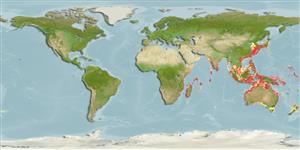Environment: milieu / climate zone / depth range / distribution range
Ecologia
marino demersale; distribuzione batimetrica 40 - 300 m (Ref. 4313). Temperate
Indo-West Pacific: Natal, South Africa to southern Japan (Ref. 4313). Two populations apparently exists, the Western Pacific and SE African coast (Ref. 54479).
Size / Peso / Age
Maturity: Lm ? range ? - ? cm
Max length : 38.0 cm TL maschio/sesso non determinato; (Ref. 90102)
Spine dorsali (totale) : 13; Raggi dorsali molli (totale) : 9; Spine anali: 2; Raggi anali molli: 7 - 8. Long filaments at the tips of the dorsal fin spines and outer rays of the caudal fin (Ref. 48635).
Usually found in sheltered coastal bays and fine sand or muddy habitats. May partly bury itself in the substrate during the day and is easily overlooked. When disturbed, the brightly colored pectoral fins probably serves to startle predators. The large fins serve primarily to corner prey when hunting (Ref. 48635). Trawled on soft bottom in coastal waters (Ref. 4313), to 300 m depth (Ref. 48635).
Life cycle and mating behavior
Maturities | Riproduzione | Spawnings | Egg(s) | Fecundities | Larve
Eschmeyer, W.N., 1986. Scorpaenidae. p. 463-478. In M.M. Smith and P.C. Heemstra (eds.) Smiths' sea fishes. Springer-Verlag, Berlin. (Ref. 4313)
IUCN Red List Status (Ref. 130435)
Human uses
Pesca: commerciale; Acquario: Commerciale
Strumenti
Special reports
Download XML
Fonti Internet
Estimates based on models
Preferred temperature (Ref.
123201): 14.9 - 26.8, mean 22 °C (based on 553 cells).
Phylogenetic diversity index (Ref.
82804): PD
50 = 0.7500 [Uniqueness, from 0.5 = low to 2.0 = high].
Bayesian length-weight: a=0.01023 (0.00444 - 0.02358), b=3.01 (2.82 - 3.20), in cm total length, based on LWR estimates for this (Sub)family-body shape (Ref.
93245).
Trophic level (Ref.
69278): 4.1 ±0.7 se; based on size and trophs of closest relatives
Resilienza (Ref.
120179): Basso, tempo minimo di raddoppiamento della popolazione 4.5 - 14 anni (Preliminary K or Fecundity.).
Fishing Vulnerability (Ref.
59153): Low to moderate vulnerability (28 of 100).
